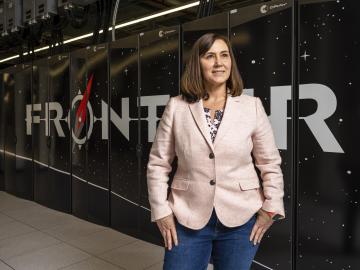
Filter News
Area of Research
News Topics
- (-) Cybersecurity (2)
- (-) Energy Storage (1)
- (-) Environment (15)
- (-) Exascale Computing (16)
- (-) Space Exploration (1)
- (-) Transportation (3)
- 3-D Printing/Advanced Manufacturing (2)
- Artificial Intelligence (22)
- Big Data (16)
- Bioenergy (3)
- Biology (6)
- Biomedical (7)
- Biotechnology (1)
- Buildings (2)
- Chemical Sciences (1)
- Computer Science (46)
- Coronavirus (7)
- Frontier (17)
- Grid (1)
- High-Performance Computing (25)
- Isotopes (1)
- Machine Learning (8)
- Materials (4)
- Materials Science (8)
- Mathematics (2)
- Microscopy (2)
- Nanotechnology (5)
- National Security (3)
- Neutron Science (6)
- Nuclear Energy (2)
- Physics (4)
- Quantum Computing (11)
- Quantum Science (11)
- Security (2)
- Simulation (12)
- Software (1)
- Summit (22)
Media Contacts

Wildfires have shaped the environment for millennia, but they are increasing in frequency, range and intensity in response to a hotter climate. The phenomenon is being incorporated into high-resolution simulations of the Earth’s climate by scientists at the Department of Energy’s Oak Ridge National Laboratory, with a mission to better understand and predict environmental change.

With the world’s first exascale supercomputer now fully open for scientific business, researchers can thank the early users who helped get the machine up to speed.

To support the development of a revolutionary new open fan engine architecture for the future of flight, GE Aerospace has run simulations using the world’s fastest supercomputer capable of crunching data in excess of exascale speed, or more than a quintillion calculations per second.

At the National Center for Computational Sciences, Ashley Barker enjoys one of the least complicated–sounding job titles at ORNL: section head of operations. But within that seemingly ordinary designation lurks a multitude of demanding roles as she oversees the complete user experience for NCCS computer systems.

A trio of new and improved cosmological simulation codes was unveiled in a series of presentations at the annual April Meeting of the American Physical Society in Minneapolis.

Environmental scientists at ORNL have recently expanded collaborations with minority-serving institutions and historically Black colleges and universities across the nation to broaden the experiences and skills of student scientists while bringing fresh insights to the national lab’s missions.

ORNL researchers are deploying their broad expertise in climate data and modeling to create science-based mitigation strategies for cities stressed by climate change as part of two U.S. Department of Energy Urban Integrated Field Laboratory projects.

A new version of the Energy Exascale Earth System Model, or E3SM, is two times faster than an earlier version released in 2018.

The daily traffic congestion along the streets and interstate lanes of Chattanooga could be headed the way of the horse and buggy with help from ORNL researchers.

An international problem like climate change needs solutions that cross boundaries, both on maps and among disciplines. Oak Ridge National Laboratory computational scientist Deeksha Rastogi embodies that approach.


